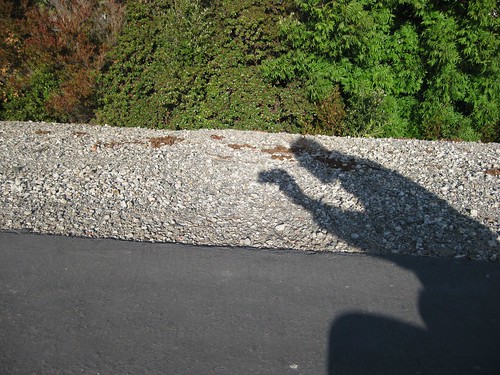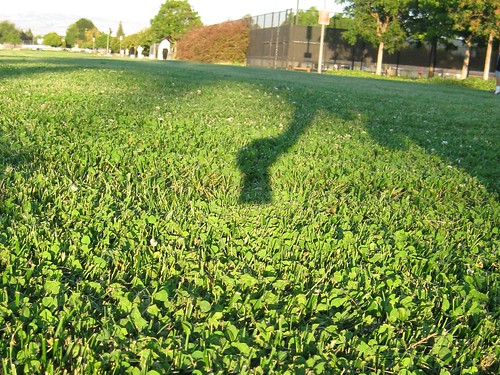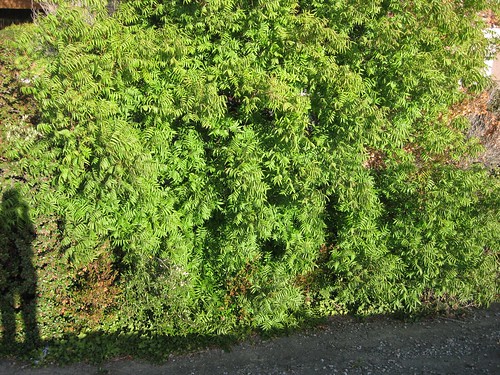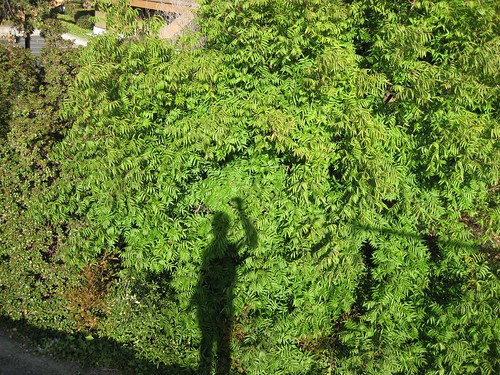 The shadow opposition effect is one of the most common optical phenomena, and once you know what it is, you might start seeing it everywhere.
The photo above shows some ordinary gravel on the side of a bike path. Things get more interesting if you look at the same area from a different angle:
The shadow opposition effect is one of the most common optical phenomena, and once you know what it is, you might start seeing it everywhere.
The photo above shows some ordinary gravel on the side of a bike path. Things get more interesting if you look at the same area from a different angle:
 This photo shows the same gravel, but a few feet from the side, and we are now looking at the shadow of the camera. Immediately around the shadow, there is a subtle but distinct brightening of the image. This brightening gives the appearance that the gravel there is lighter in color, when in fact it is not.
This is the shadow opposition effect, which is where the gravel near the antisolar point appears brighter because it contains more sunlit surface and less shadow than the gravel off to the side. This is sometimes described as “shadow hiding” — since you don’t see the shadows on the ground near your own.
This photo shows the same gravel, but a few feet from the side, and we are now looking at the shadow of the camera. Immediately around the shadow, there is a subtle but distinct brightening of the image. This brightening gives the appearance that the gravel there is lighter in color, when in fact it is not.
This is the shadow opposition effect, which is where the gravel near the antisolar point appears brighter because it contains more sunlit surface and less shadow than the gravel off to the side. This is sometimes described as “shadow hiding” — since you don’t see the shadows on the ground near your own.
 At this park, it’s a little easier to make out the individual shadows from the clover and grass, so you can really see the “shadow hiding” mechanism at work– it’s easy to see that the grass itself is not a brighter color near the shadow of the camera.
[Aside: It’s important to note that the shadow opposition effect is only the most common of several opposition effects. In a fog, cloud, or mist, glories can appear around your shadow. When larger drops of water are present– such as on dew-covered grass– Heiligenschein can produce a true backscattering effect, where the appearance is similar to the shadow opposition effect. A more obscure opposition effect called coherent backscattering may be responsible for the high brightness of the full moon.]
At this park, it’s a little easier to make out the individual shadows from the clover and grass, so you can really see the “shadow hiding” mechanism at work– it’s easy to see that the grass itself is not a brighter color near the shadow of the camera.
[Aside: It’s important to note that the shadow opposition effect is only the most common of several opposition effects. In a fog, cloud, or mist, glories can appear around your shadow. When larger drops of water are present– such as on dew-covered grass– Heiligenschein can produce a true backscattering effect, where the appearance is similar to the shadow opposition effect. A more obscure opposition effect called coherent backscattering may be responsible for the high brightness of the full moon.]
The examples that we’ve seen thus far have been rather planar, but here is a more three-dimensional example:


On the first photo are some bushy trees, photographed from the side. In the second, we’ve moved the camera so that the same part of the bushes are now at the antisolar point from our camera. Even though the position of the leaves is so irregular, the effect is still clear.
Taking it a little further yet, here’s a movie– taken on a bike ride –showing the shadow opposition effect over different textures and distances. (The video is embedded below, if you can’t watch it here, you can click through to see it on youtube.)



I’m afraid to say I don’t see a freaking thing here :(
Me neither, for a long time! :(
I thought it might have been a joke initially… But check out the link that he posts, that explains the effect quite well. Once you get it it’s so obvious that I felt silly not seeing it. Note that almost all of the images are brighter in the center…
Basically: Objects hide their own shadow to some extent that depends on the direction of the illumination and the direction of the camera. So, different areas of the photo will appear brighter or darker, depending on whether the arrangement of light, objects and camera allows you see more of the shadows or the objects.
I think the article could have been better worded, since there’s 2 sorts of "shadow": The shadow of the camera (and photographer) and the shadows cast by each bit of gravel.
I think I just learned something. :)
Nor do I, the gravel near the shadow looks just the same as the gravel well away from the shadow.
Unless your digital camera introduces artifacts, or the photos were taken in early April, I believe it’s spoilt.
This is exactly the same effect that happens to folks who like to run at night. Forehead-mounted lights are fantastic, but the angle of the light is so close to the angle of the eyes that you can’t see shadows where you’re looking, which means no texture or depth information, which means more sprained ankles. Cool post!
I do not see any "opposition", I do see that there are less visible shadows in some of the pictures that make the contrast go down on the camera.
Yeah, i honestly don’t really see much difference. Maybe a little bit more contrast in the second gravel pic, but that’s about it. Plus i don’t think I want to put a shadow of me taking a photo into the photo itself just to increase the contrast.
I think it is hard to photograph, but not too hard to see in person. Give it a try yourself outside somewhere and maybe you’ll be able to see it better.
I see what you’re indicating — that at the center of the image, directly opposite the sun, you see fewer shadows in a textured surface.
Unfortunately, I’m also seeing that your camera does some vignetting, which also increases the brightness at the center relative to the edges, which could make for some confusion.
I’m not seeing significant vignetting. The photo at the top, for example, is not cropped, and does not appear–to me– to be brighter in the center.
—
Windell H. Oskay
drwho(at)evilmadscientist.com
http://www.evilmadscientist.com/
Ah, sort of like gegenshein:
http://en.wikipedia.org/wiki/Gegenschein
Dave
There’s another odd effect here too. To me at least the gravel path appears to have quite a strong convex camber in the second photo, even though it’s clear from the first that it’s pretty much flat. Anybody know what’s going on there, or are my eyes screwed from staring at Cisco configs all day?
The path is slightly curved, that’s all.
—
Windell H. Oskay
drwho(at)evilmadscientist.com
http://www.evilmadscientist.com/
I agree. With the lack of shadows towards the center, and the other shadows pointing towards the center, it gives the objects a concave look as well.
How does this help me achieve world domination?
Simpy draw everyone’s attention to this effect, and when they’re completely absorbed in that, they won’t be paying attention to you.
I agree, it’s a neat effect once you notice it. Those who can’t see it in the second photo might need to adjust their monitor gamma (just a guess.)
This effect was completely stunning when I was on a ridge on Mt Hood at sunrise. I could see my shadow cast out over the forest, with an amazing opposition effect surrounding me in the trees dozens of miles away.
I’ve seen a great example when hot air ballooning. It actually looks like the area around the balloon shadow is much much brighter.
I saw this riding in a small plane over a forest. When the sun was at our back there was a bright strip across the trees kind of like the reflection off of a curved metal surface. The strip moved along with us. It was almost like the trees were acting like a mirror of some type. This is a much better explaination.
There is a bit of brightening, but the most striking thing one sees in the video is that the area immediately around the center of the shadow cast by the camera appears more uniform, less contrasty, than its surrounding area.
I’m sure there’s a way to make a sort of steganography project that relies on this.
That disappearance of the shadows– which you and a few other folks are describing as a "loss of contrast"– is the very effect that we’re talking about.
—
Windell H. Oskay
drwho(at)evilmadscientist.com
http://www.evilmadscientist.com/
guys, are you blind?
It’s right there! I see it, I see it.
I have observed this elsewhere. When you look at a street light trough a tree with alot of shiny twigs without leaves (Birch in an autmn for example) with the twigs being close to the lamp and inbetween the lamp and you. you can see the reflection shine only of the twigs that are oriented tangetally to any of the circles arounf your axis of sight
There are some nice examples in pictures taken on various Apollo missions. Try this one: http://www.nasa.gov/images/content/383410main_apollo12_alsep_full.jpg
As an artist, I had been using similar effects in my pictures simple because it looked right. I’m amazed to see there’s an actually phenomena in reality.
When my father used to fly his Cessna I would always notice this when looking at our shadow on the ground. Its much easier to notice up there because of the height and broad viewing angle. I always wondered to myself what was going on and its very cool to know that this actually has a name!
I first noticed this from airplanes as well. :)
—
Windell H. Oskay
drwho(at)evilmadscientist.com
http://www.evilmadscientist.com/
I was looking through the flickr feed ogling the new bulbdial clock kit, and when I saw the pictures here, I immediately knew what the post was about having noticed this phenomena myself.
Another opposition effect I don’t get to observe nearly often enough also is best viewed from a plane:
Watch the shadow of the plane on the ground, and if it passes near to road signs, particularly large highway signs, they suddenly flare with brightness as the retroreflective coatings send the sun’s light right back to you. Easiest to notice on approach or takeoff as being near the city, there’re lots of signs, they’re still of noticeable size, and it’s easy to find the shadow.
If you stare long enough you will see a fighter jet Cool
And all these years I simply assumed that I had a halo.
At a different angle there may very well be more light being reflected in the direction of the camera.
For comparison, there should be a photo with a shadow, a photo without. The camera should be in the same position and all camera settings should be held constant (manual everything naturally).
My understanding is that the effect is due to how the brain deals with contrast
Right: "Pardon me while I turn off the sun."
Windell H. Oskay
drwho(at)evilmadscientist.com
http://www.evilmadscientist.com/
A time-lapse video would visualize how the effect works, I should think.
Actually, a 100% crop of the area immediately surrounding the shadow, but not including the shadow, could be juxtaposed next to a 100% crop of another area of the image, to show that they are the same luminance, etc.
The thing is, from what I saw looking at the pictures, the reason why the image looks brighter around the camera is because the angle of the sun is such that any shadows cast by an object such as the leaves, grass, etc, would be almost completely in line with, and thus obscured, by the object itself, so there is, in fact, more light and less shadow in that part of the picture.
The brightness of an individual pixel in that area may not be brighter, but the average brightness, due to the object obscuring its own shadow, is certainly higher.